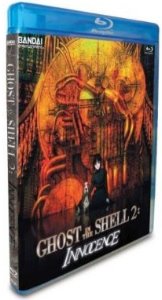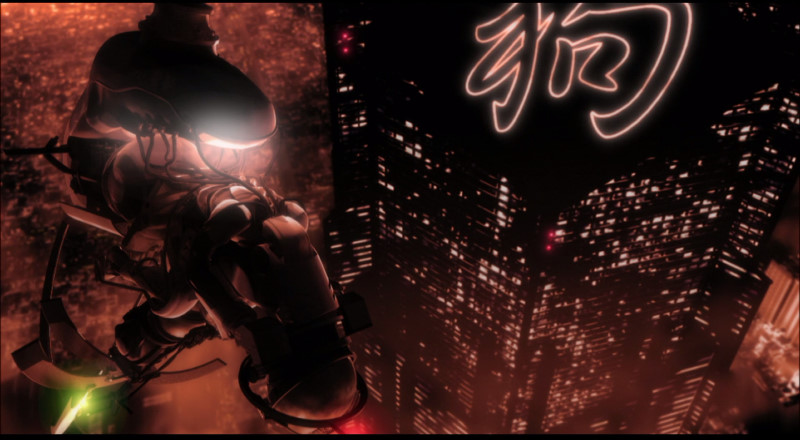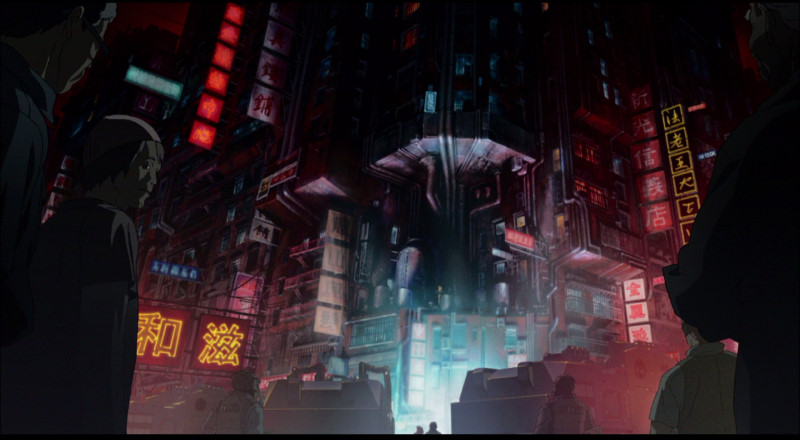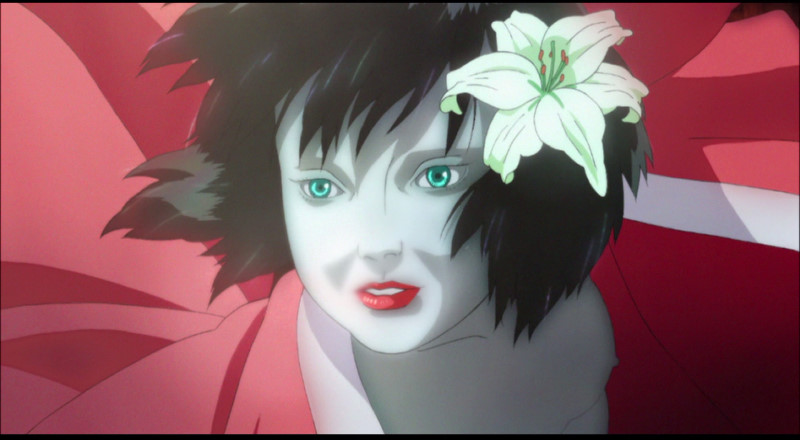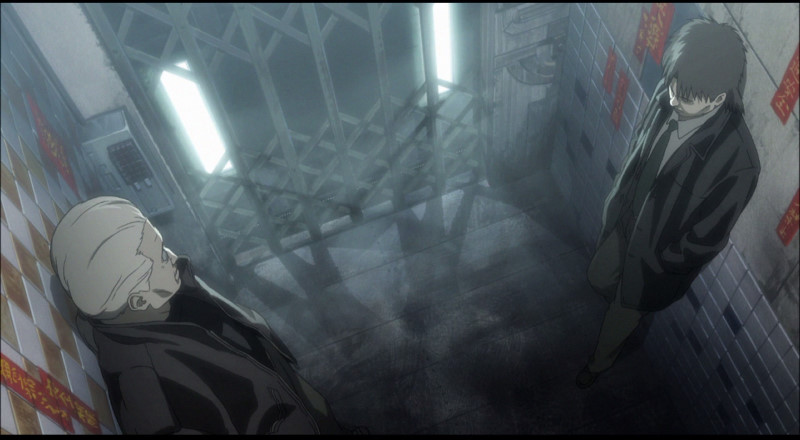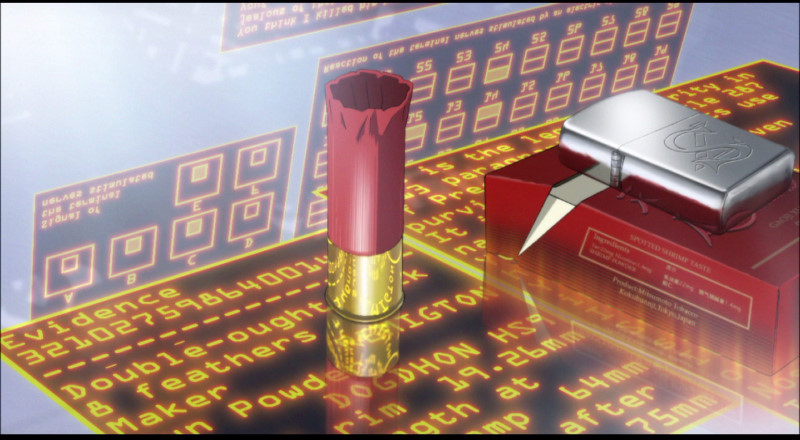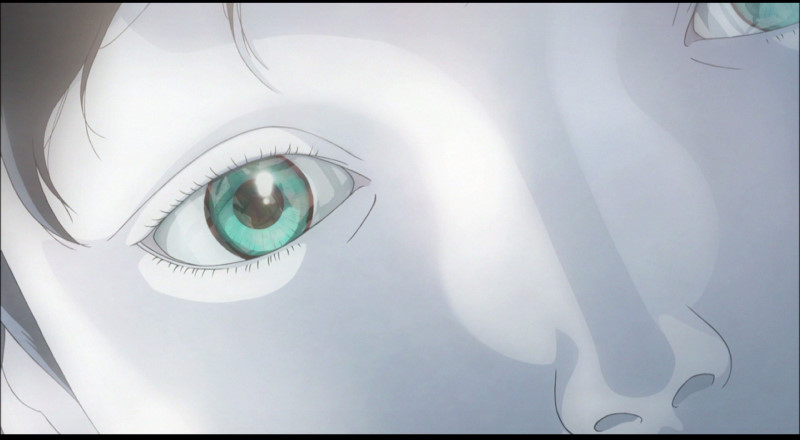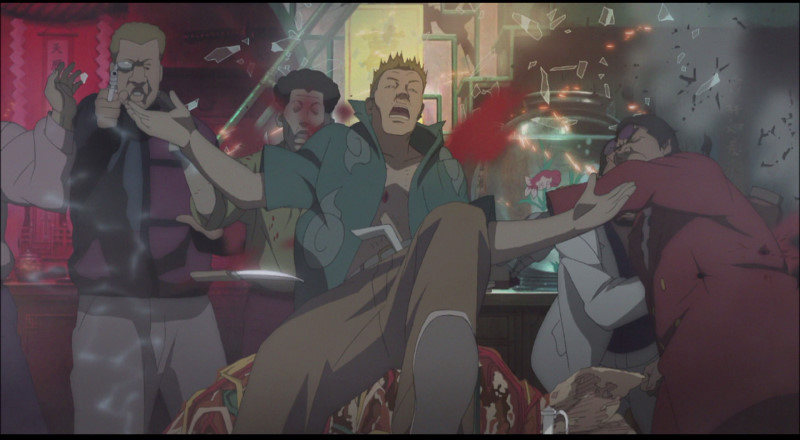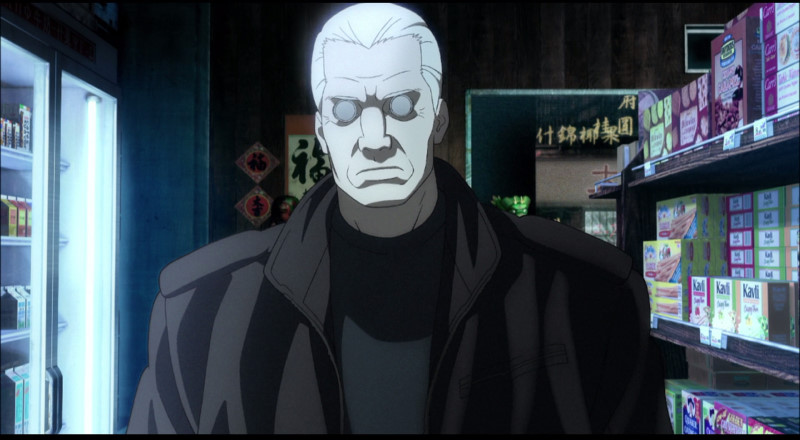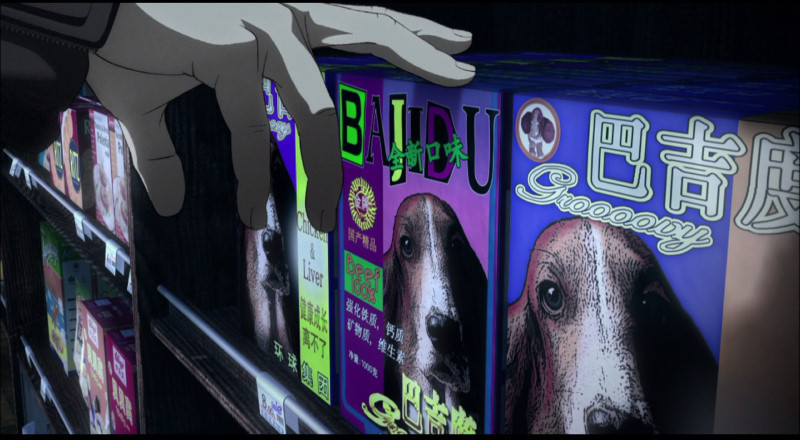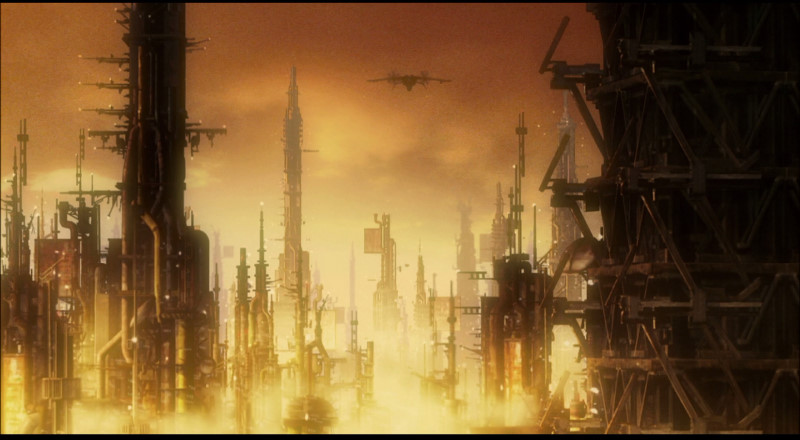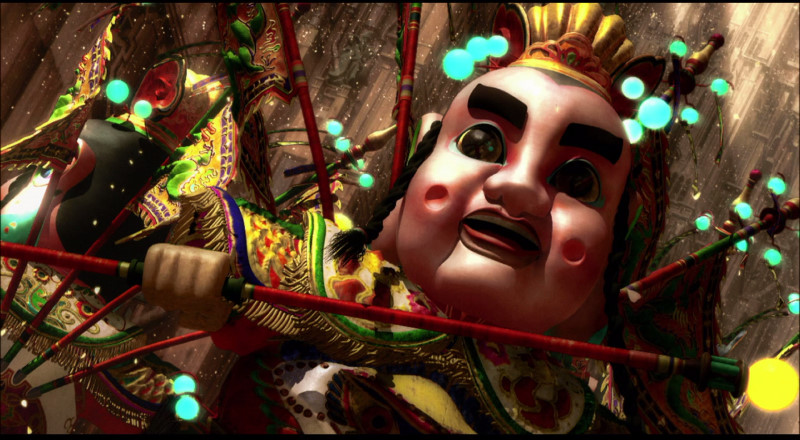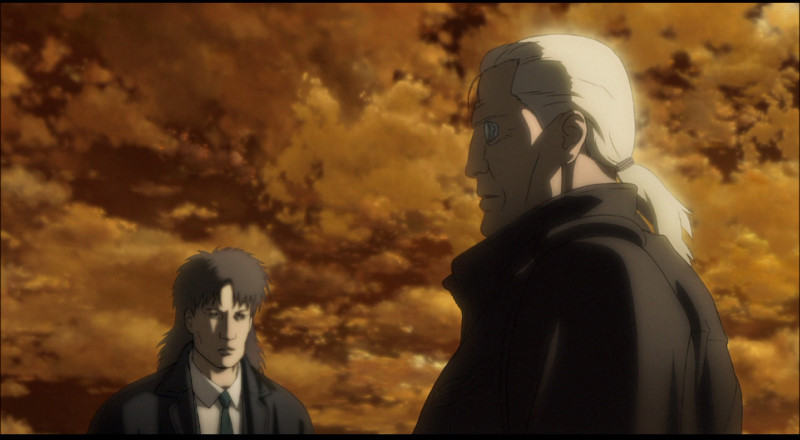Ghost in the Shell 2: Innocence Blu-ray US Version
(Mamoru Oshii - 2004)
Review by Leonard Norwitz and Gary Tooze
Studio: Bandai Entertainment
Video:
Aspect ratio: 1.85:1
Chapters: 20
Feature film: 1080p /
MPEG-4 AVCDisc Size: 22,648,495,089 bytes
Feature Size: 21,068,384,256 bytes
Time: 1:40:30.065
Average Bitrate: 27.95 Mbps
Bitrate:
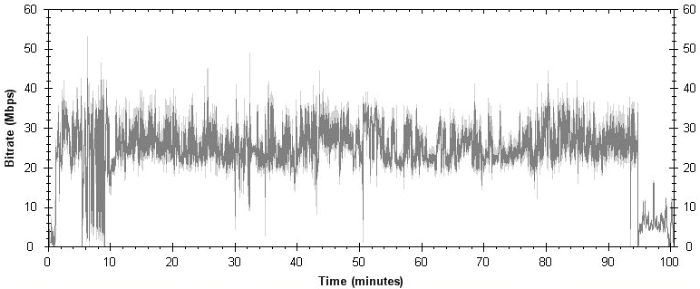
Audio:
Dolby Digital Audio English 640 kbps 5.1 / 48 kHz / 640 kbps
Dolby Digital Audio English 640 kbps 5.1 / 48 kHz / 640 kbps
Dolby Digital EX Audio Japanese 640 kbps 5.1-EX / 48 kHz /
640 kbps
Dolby Digital Audio Japanese 192 kbps 2.0 / 48 kHz / 192
kbps
Subtitles:
English (yellow), none
Extras
• Commentary, in Japanese, with Director Oshii and Producer Ishikawa (with yellow English subtitles optional)
• 16 minute SD 'Making of'... (Japanese with optional English subtitles)
• Trailer & Bandai Previews
Single disc in a standard Blu-ray case.
Release Date: January 13th, 2009
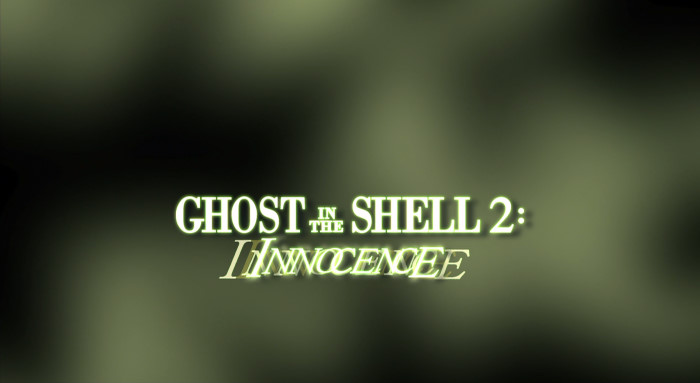 |
NOTE: This I.G. Cinema Selection Blu-ray DVD of Ghost in the Shell: Innocence will play on North American Blu-ray players. Blu-ray discs are usually region-coded (e.g. Warner Blu-ray are not, Buena Vista are). Unlike SD DVDs, which are coded for one or all of 6 regions - see HERE, there are only 3 regions for Blu-ray: North, Central and South America share Region A/1 with Japan, Korea, Hong Kong, Taiwan and most of what we call Southeast Asia. Europe, Greenland, Africa, Australia, New Zealand and the Middle East comprise Region B/2. Region C/3 is the remainder of Asia, including: (Mainland) China, India, Pakistan and Russia. See Blu-ray region Coding map HERE
Ghost in the Shell 2: Innocence
Following upon his first Ghost in the Shell animé feature film, as if two entire TV series did not exist between them, Mamoru Oshii picks up after Major Kusanagi retires herself (sort of like Dr. Who, I always thought). Batou, her bionic partner in the special police unit known as Section 9 that investigates cybercrime, together with Togusa, one of the younger, mostly human, cops (with a family, no less), is now looking into the murders of owners of robot-dolls by the dolls themselves who, in turn, self-destruct.
I've seen the movie three times now, twice on SD-DVD and just now on Blu-ray. I can't say that I can follow the convolutions of the plot exactly – not, I suspect, because it is opaque or confusing – though there are those aspects, but because I get utterly caught up in the astonishing visuals, the music and the soundtrack. From its first frames, we are aware that Ishii has taken the art form in a new direction – as did Wagner between the second and third acts of Siegfried. Purists will have complained about so much CG in what, after all, had been a fairly static presentation, with time-honored, if parochial, conventions: Animé should be thought of as a comic book in motion, rather than a stand-in for real people and places. This is why jaws go up and down, but lips don't sync, and why backgrounds are relatively immobile, and why lateral motion is so staggered, suggesting movement from graphic pane to graphic pane.
Over the few years since the movie's release I've read the occasional review, hoping to gain some further insight into its context. I can only say that there are some disappointed critics out there. One of their complaints was how much intellectualizing and philosophizing there was in this movie – as if that isn't what characterizes animé more than any other cinematic medium – and that the sheer volume of dialog threatened to overwhelm the story. But I suspect that many are simply not up to the task of sifting through the layer upon layer of interdependent literary, philosophical, cultural and political references. Not that that I'm that much more astute – I'm just reluctant to kill the messenger just because I don't get it. I was fully prepared to write a review that would say just about that much and throw in some nice comments about the picture and sound and, hopefully, not embarrass myself. But then . . .
Last week I had a few friends over to choose whatever BD they wanted to watch and, to my surprise, they picked Innocence. True, they were enticed by the brief segment I played (you can probably guess which), but what really got their juices going was the screenplay (in translation, no less) and how the visuals supported it. So, without getting into the plot, here's their summary (with many, many thanks to Lee Chen & Michael Barry). There's a feast to chew on here, so sit back and make yourself comfortable:
The film, Innocence, expresses an acute cultural anxiety through its use of simulacra, namely dolls, ghosts, puppets, cyborgs and prosthetically modified humans. It draws heavily on the tradition of early twentieth-century literature that invokes anthropomorphized objects (especially those with human form) to make social and metaphysical commentaries and criticisms. The primary references here are E. T. A. Hoffman’s short story Der Sandmann (the inspiration for the ballet, Coppélia) and Rainer Maria Rilke’s Duino Elegies. Both works attempt to position the human between the material/mechanical world of puppets and the immaterial/spiritual world of angels. Puppets and angels, unlike humans, are inherently innocent, but both are “dead,” as we all will one day be. Therefore, the puppet and angel stand, potentially, as past and future selves. Rilke’s Fourth Elegy makes this explicit.
One cannot view Innocence thinking that the imagery in this poem was implicitly present throughout. The Fourth Elegy, in turn, was inspired by a Kleist essay Puppet Theater. Also, Rilke wrote an intriguing essay entitled On Toys which can be found in the book Rodin and Other Prose Pieces.
Interestingly, the early 20th century anxiety surrounds the “mechanization” of the world – hardware approximating human body. In Innocence, the anxiety surrounds the “computerization” of the world – software approximating the human soul. Unlike Blade Runner, where the main questions seem to be “How long will I live?” and “Does she love me?” (both very American concerns), Innocence presents the Japanese concern of “Do I still have a soul?”
Also note that, in Innocence, the photo book that has the picture of the little girl in it was a title by Hans Bellmer. Given that the dolls depicted in the movie were virtual copies of Bellmer’s, I can see why the filmmakers felt the need to reference him directly.
HERE
As we can see, crises of identity invariably create artistically-rendered sexual mutilations of the body to represent the corruption/deformation of the “soul.” This arises from the fact that, as William Gass wrote, “Consciousness is nothing. No thing. A gunnysack full of Polish teeth occupy for space in this world than all the agony of their extraction.”
LC/lmn
Innocence portrays a Japan that has ceased to be the maker of things. Material production has become China’s province, as represented in the lavish, brilliantly colored Chinese barge imagery that dwarfs the grey-garbed Japanese interlopers. The question for the Japanese then is less “Do I still have a soul?” than “Am I real?” Although Japanese animé is one of the more successful Japanese exports at present - their bleak vision reflects the depressed Japanese business market. The absence of Japanese automobiles in the future is also telling. The ersatz “nostalgia” for foreign cars bespeaks a rejection of the mundane – preferring instead the hyper-reality of “noir.”
MB/lmn
The Movie : 8
In the immortal words of Ahme, "I can say no more."
Leonard Norwitz
Image : NOTE: The below Blu-ray captures were ripped directly from the Blu-ray disc.
I don't own either of the Japanese Blu-ray versions covered by Leonard HERE and the 'Absolute Edition' reissue HERE but can see this is dissimilar in a few areas. This North American release (although I believe the Japanese Blu-rays were region 0 anyway) is single-layered where the 'reissue' was dual. Also this does not appear to be the original (also single-layered) as it is encoded with MPEG-4, not MPEG-2. It does not have Japanese subtitle options, includes two English DUBs, and offers subtitles on the extras.
Digital animation is generally perfect in that there are usually no artefacts that can be inherent with live-action transfers. Haze or blurring is intentional to give a representation of movement. Colors looks okay and the image softer than I would have expected but certain segments of the Ghost in the Shell 2: Innocence are extremely impressive.
I have no frame of reference and suspect this all looks to faithfully replicate the intended appearance.
CLICK EACH BLU-RAY CAPTURE TO SEE ALL IMAGES IN FULL 1920X1080 RESOLUTION
Audio & Music: We are given a 5.1-EX in original Japanese track and two different English 5.1 DUBs ('Entertainment' DUB and 'Manga UK' DUB). I'm still investigating the differences but voices are definitely not the same for certain characters (ex Haraway's voice is deeper and more resolute on the second DUB.) This is probably a testament to the fan-base and many complaining about lack of an English DUB on previous Japanese Blu-rays.
As Leonard says about the 6.1 EX track:
From the subtle noir song, Crystal Memories and the tasteful Follow Me (set to the familiar strains of the Concierto di Aranjuez), to the almost screaming vibrato-less choir and its crashing drums, to the ghostly musical bells, the music track is jaw-droppingly fabulous – in conception and execution. Add to this a dynamic in-your-face effects track (especially the aeroplanes and helicopters), and you have one of the best audio mixes on disc.Extras:
16-minute Making of in Japanese with optional English subtitles and the same commentary available on the other Japanese releases but with optional English subtitles. No liner notes, but a GitS2:I trailer and some Bandai adverts.
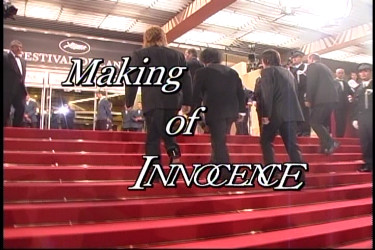 |
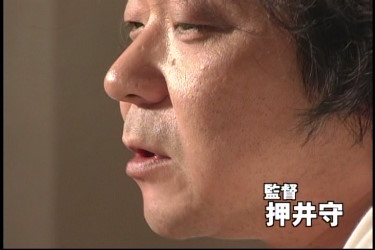 |
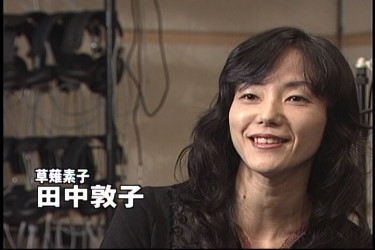 |
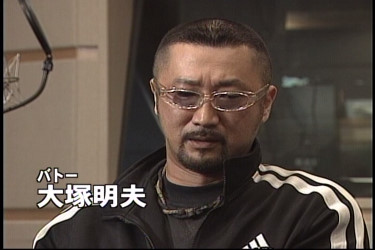 |
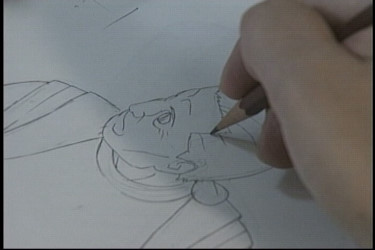 |
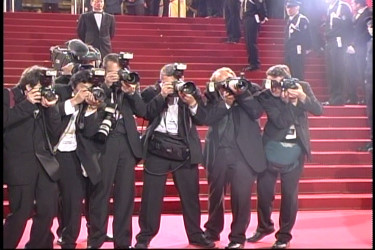 |
BOTTOM LINE : This is more than half the cost of the Japanese edition(s), removes the higher audio (offered is still highly competent) but includes DUBs for the feature and subtitles for the extras. I expect the image is not identically pristine as the 'Japanese reissue' but perhaps with subtle enough differences to make this US edition very viable with essential value for fans tempering their digital spending. This certainly gives you the best 'bang for your buck' - no question.
Gary Tooze
January 8th, 2009
